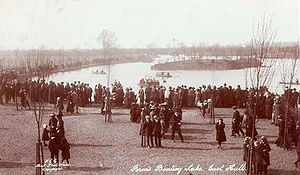
East Park, Hull
Encyclopedia

Kingston upon Hull
Kingston upon Hull , usually referred to as Hull, is a city and unitary authority area in the ceremonial county of the East Riding of Yorkshire, England. It stands on the River Hull at its junction with the Humber estuary, 25 miles inland from the North Sea. Hull has a resident population of...
, East Riding of Yorkshire
East Riding of Yorkshire
The East Riding of Yorkshire, or simply East Yorkshire, is a local government district with unitary authority status, and a ceremonial county of England. For ceremonial purposes the county also includes the city of Kingston upon Hull, which is a separate unitary authority...
, England
England
England is a country that is part of the United Kingdom. It shares land borders with Scotland to the north and Wales to the west; the Irish Sea is to the north west, the Celtic Sea to the south west, with the North Sea to the east and the English Channel to the south separating it from continental...
. East Park is registered a Grade II listed site by English Heritage
English Heritage
English Heritage . is an executive non-departmental public body of the British Government sponsored by the Department for Culture, Media and Sport...
.
History
East Park first opened to the public on 21 June 1887—the day the country celebrated Queen Victoria's Golden Jubilee. About 20 years earlier, in the west of the city, Zachariah Pearson had established Hull's first public park, which was initially known as The People's Park and later simply as Pearson ParkPearson Park
Pearson Park was the first public park to be opened in Kingston upon Hull, England. It is situated about northwest of the city centre of Hull with its main entrance on Beverley Road and its western boundary adjoining Princes Avenue. It provides a range of popular leisure facilities for local...
. Then, in 1882, with Pearson Park established in the west, the Parks Committee began to look at possible locations for a park in the east. They eventually decided on a site close to the terminus of the horse-drawn tramway which ran along Holderness road, and they agreed to pay £16,909 7s 6d to Mrs Anne Watston's Trust for 38 acres 2 roods and 24 perches of her land (approx. 15 ha). An insight into how East Park's Victorian founders came to choose its site, and into their hopes for the role it might play within the community, is found in the accountant's report of 1883.
"...A more picturesque locality of that extent it would be impossible find on the East side of the Borough or one more adapted to restore the jaded energies of the artisan or man of business when the labours of the day are ended.".
Work was soon under way to construct the city's new green space, and by 1886 the project was providing 140 much needed jobs in a time of high unemployment, with the possibility that the total figure might climb as high as 200. Most of the men were earning up to 18s a week but around ten were paid a couple of shillings more. When Jubilee Day arrived the following summer, large crowds lined the route of a parade which marched from the city centre, where a new covered market was officially opened, along Lowgate, Whitefriargate, and Holderness Road to its end point in the new park. There is no record of any official decision to adopt the name East Park, and at the opening ceremony Alderman W.F.Chapman suggested that it should be called Victoria Park. However, East Park it remained, and as local historian Mary Fowler remarks "...with the economy of expression so common in these parts, East Park is, as often as not, just 'Park' to the people of East Hull.".
From the beginning East Park and its counterpart in the west were focal points for many kinds of recreational activity. East Park did not offer the archery and quoits
Quoits
Quoits is a traditional game which involves the throwing of metal, rope or rubber rings over a set distance, usually to land over or near a spike . The sport of quoits encompasses several distinct variations.-The history of quoits:The history of quoits is disputed...
available in Pearson Park, but football, cricket, tennis and bowls were popular. The Model Yacht Pond had its own Yacht House and a flagpole for team colours. Enthusiasts could read about competitions involving the tiny craft in the local newspaper: an edition in June 1912, for example, revealed that the boats had to contend with "a light northerly breeze, the course being a beat to windward.". Concerts in both parks drew large audiences: a performance in Pearson Park, one Friday evening in July 1901, entertained 15,000 spectators.
The popularity of East Park kept the authorities busy. When The Shop Assistants Union complained that its late-working members were unable to attend the concerts, and so "girls of 13 and 14 years never have a chance to hear the music", they found a champion in Hull Daily Mail
Hull Daily Mail
The Hull Daily Mail is the local daily newspaper for Kingston upon Hull, East Riding of Yorkshire and is published along with the free weekly, Hull Advertiser. There used to be a weekly sports paper, the SportsMail, but this folded in 2006...
columnist "Mother Humber", who wanted the concerts moved to Thursday, which was early-closing day. Footballers' poor behaviour and swearing were cause for concern for the Parks Superintendent, but the cricketers and the model-boaters appear to have escaped his disapprobation. Bowls, like tennis, required careful handling when assessing the competing claims of the general public and organised teams, all of whom wanted access to the facilities during the few short hours "when the labours of the day are ended".

